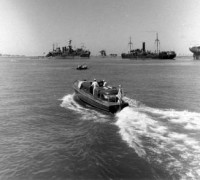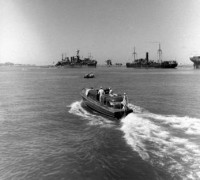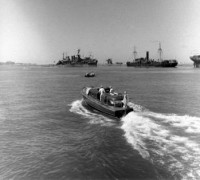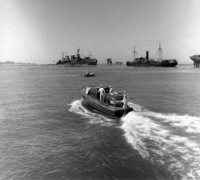U S NAVY 4th FLEET AT RECIFE - SHIP INDEX CL CG CP CVE
11)CVE 67 SOLOMONS
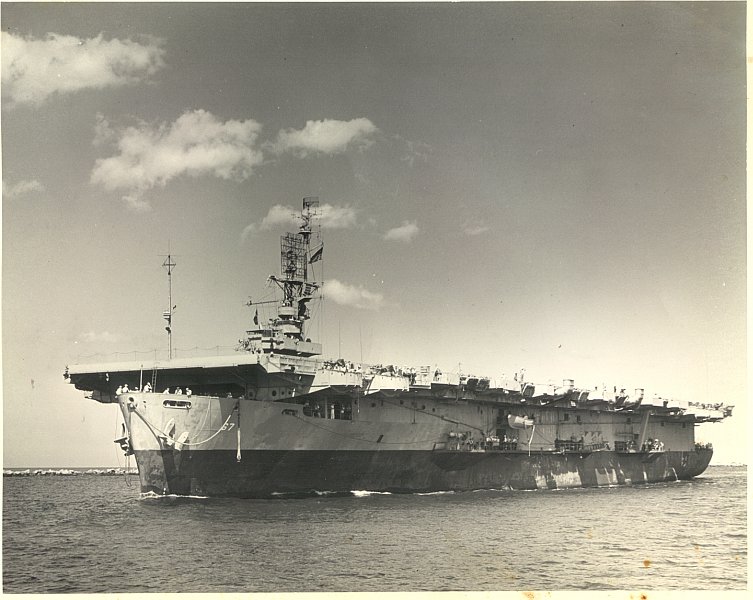
Photo. www.navsource.org By William Thornton
CLASS
Displacement: 10,400 tons (full load)
Length: 512'3"
Beam: 65'2"
Extreme Width: 108'1"
Draft: 22'6"
Speed: 19.3 k. (trials speed)
Complement: 860
Armament: 1 5"; 16 40mm
Aircraft 27
She departed
On 12 February 1944 a radar contact was made and torpedo defense was sounded. The USS FITCH DD 462 left the formation to investigate but there was no further radar contacts. The ship arrived in
After repairs were finished the loading of planes, supplies, and aviation stores commenced and the USS SOLOMONS CVE 67 got underway on 21 March 1944 bound for
On 25 March 1944 a torpedo bomber crashed into the after part of the SOLOMONS flight deck. The USS EISNER DE 192 quickly picked up the pilot and crew. On 30 March 1944 the USS SOLOMONS CVE 67 crossed the Equator. On 31 March 1944 the USS TRUMPTER DE 180, USS STRAUB DE 181, and USS GUSTAFSON DE 182 joined the USS SOLOMONS CVE 67. On 6 April 1944 a sound contact was reported but further investigation proved negative. They arrived in
The Composite Squadron NINE was disembarked to the Ibura Airfield,
Departing
The pilot, who had made the initial contact on the submarine, was shot down by enemy antiaircraft fire. Lieutenant Commander Avery, another pilot from the USS SOLOMONS CVE 67 sighted the wake at 1654 of a fully surfaced submarine. When he was 8 miles from the submarine it altered course and as the plane closed the distance the sub began to run in circles of about 1,000 feet in diameter, successfully keeping the aircraft on its stern.
During maneuvers intense anti-aircraft fire was directed at the plane as he circled the submarine at a range of 4,000 yards awaiting assistance. Ensign Wadsworth in Fighting Squadron-17, Ensign McMahon in Fighting Squadron-23, and Ensign Spear in Attack Bomber- Squadron-ll were about to land aboard the carrier when the contact report was made. They were vectored to the scene of the contact.
USS STRAUB DE-181 and HERZOG DE-178 were ordered to proceed to the scene of the contact immediately. McMahon and
After this attack, in which four planes passed over the sub in a period of 10 seconds, the submarine straightened out, trailing oil, at a slow speed, and still directing anti-aircraft fire at the planes. Lieutenant (j.g.) Chamberlain and Lieutenant (j.g.) Weigle then took off to proceed to the scene of the attack. Weigle was directed to make a rocket attack, preceded by McMahon, who made another strafing run on the submarine.Of eight rockets fired by Weigle, six of then hit in the lethal area directly in front of the conning tower. The fighters were out of ammunition and were ordered back to the carrier. The submarine's speed had been reduced to 3 knots and it was trailing large quantities of greenish-yellow oil. Chamberlain was directed to begin a depth charge run on the submarine and, in the face of anti-aircraft fire, went in at an altitude of less than 50 feet above the conning tower before he released two depth charges.
The depth charges caused a violent explosion which engulfed his plane and started a fire in the, bomb bay and center cockpit. He was able to make a water landing about 500 yards ahead of the submarine. Immediately after his attack the submarine began to sink bow first. Thirty to forty survivors were observed in the water. USS STRAUB DE 181 reported that 21 survivors, including the commanding officer were rescued. It was learned from the rescued prisoners that Ensign Edwards who had made the original contact was shot down.
On 18 June 1944 a Memorial Service is held on the USS Solomons, for the American Airmen and German Seamen that were Lost during the sinking of U860. The ships then steamed on, conducting her air operations. On 23 June 1944, USS SOLOMONS CVE 67 arrived in
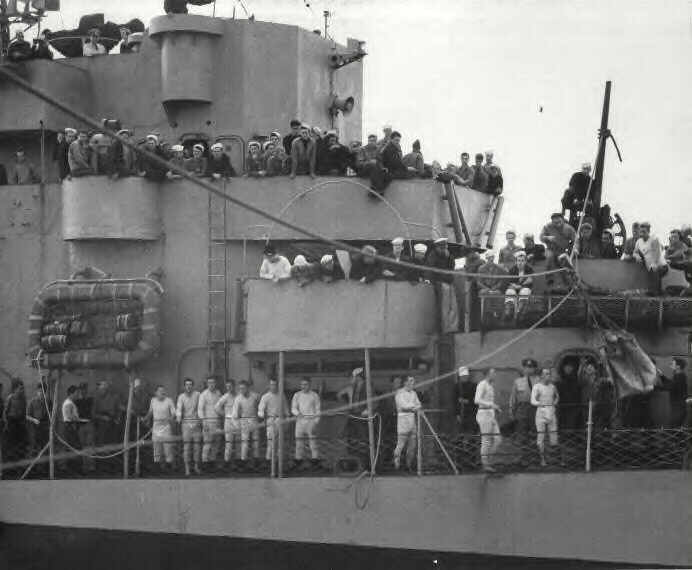
Above. U-860 survivors after being rescued by USS Solomons. Photo www.navsource.org by courtesy of Scott Koen & ussnewyork.com
.jpg)
Above last rites are addressed to one German crewmember from U-860 dead during the battle against US planes from CVE Solomons. Photo www.navsource.org by courtesy of Scott Koen & ussnewyork.com
On 1 August 1944 found the USS SOLOMONS CVE 67 in company with the USS ALGER DE 101, USS TRUMPETER DE 180, and the USS STRAUB DE 181, conducting barrier operations against enemy submarines. However no contacts were made and on 8 August 1944 she entered the
On 15 August 1944 the USS SOLOMONS CVE 67 departed
